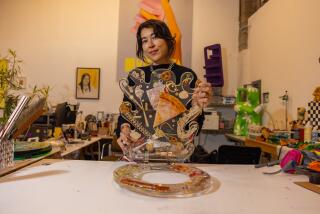VIEWPOINTS : Products Should Look Just Like What They Do
- Share via
Why do microwave ovens look like television sets? Because American industrial designers have gotten into a rut.
The people who give form to our mass-produced products have fallen into a visual habit of cubic shapes, chrome trim and dark-tinted Plexiglas to solve all imaginable design dilemmas. The modern office, for example, is tantamount to a sensory deprivation chamber with its beige panels, electronic boxes, even lighting and computer hum.
At a time when technology is getting more pervasive and more inscrutable, product designers should live up to their mission as the humanizers of the technological environment. We all need more character in our daily surroundings to offset the trend toward miniaturization and electronic tyranny in our homes and workplaces.
Fortunately, there is a movement in the product design world, small but growing, that is promoting product designs that do much more than just enclose a mechanism in the most efficient way. The movement, called product semantics or interpretive product design, looks at ways to make objects “speak” through their design about how they work or what place they might have in your life.
A good example is the stereo receiver designed by Robert Nakata, a student at the Cranbrook Academy of Art in Bloomfield Hills, Mich.
To illustrate its function, the receiver’s control buttons resemble musical notes on a sheet of music. And the buttons are placed on surfaces shaped like traditional musical instruments to reinforce the symbolism. The design also makes the receiver easier to use. The control we use the most, the volume dial, is bigger than the rest and it consists of buttons, arranged in the shape of an ear, that increase in size to show greater volume.
A few major companies have already discovered the potential of product semantics to make their products more understandable and, not incidentally, more noticeable in the marketplace. N.V. Philips, the Dutch electronics giant, under the guidance of design director Robert Blaich, recently introduced several successful products, including portable radios and small appliances, that reflect the principles of product semantics.
So do Ford’s enormously popular Taurus, with a curved form that bespeaks aerodynamics, and Sharp’s new portable radios, with their rounded, mobile-looking shape.
Obviously, not every product needs a highly expressive design. If you like to make coffee, you might want a very playfully designed coffee maker that portrays the process of heating water and pumping it through coffee grounds. But if you see coffee making as a service to be performed as efficiently as possible, then you might want a simple, inconspicuous machine.
The accompanying illustrations are from the design studio at Cranbrook, where we are experimenting with product forms that reflect the character of an object. These are projects that you probably won’t find on your store shelves tomorrow, but they represent advanced thinking about expressive product design. They demonstrate that just as artists and writers use metaphors to express ideas, product designers can use metaphors to give products meaning.
The toaster by Van Hong Tsai uses the metaphor of bread and heat to symbolize toast making. The form of the toasting chambers combines the images of bread slices and aluminum radiators with fins representing waves of heat.
Its plunger control, which is a cone pointed downward to signal the direction of the movement, is presented out front, away from the heat, for the convenience of bleary-eyed early morning users. This is a friendly, outgoing product form, for those to whom making toast in the morning is an important ritual.
Sometimes images of earlier technology create an emotional connection between new technology and the past. A case in point is the CD player by Jin Dean Cheng.
With its symmetrical, almost altar-like presentation of the compact disc enclosed by a clear dome, it evokes the era of jukeboxes and cathedral radios, when there was a romance and mystery to electronic media. The controls encircle the compact disc, suggesting a formal arrangement that reinforces the idea of celebrating the music.
The picture phone by Paul Montgomery takes the high technology of a video telephone and presents it in the form of a picture frame propped up on your desk, with the handset, camera lens and speaker arranged in the ornate frame around the central display. The abstract images of eyes and ears clarify the nature of the technology. The picture frame metaphor makes this technology comfortable in the home or the office because of its familiar imagery.
You can look at a video camera as an extension of your senses of sight and hearing as well as an expansion of your memory as you store the sights and sounds around you. The videodisc camera by David Gresham consists of five elements that symbolize that process.
The device looks like a mask penetrated by a lens and eyepiece. The mask represents the user’s persona; the lens and eyepiece suggest vision; the disc symbolizes memory, and holding all these elements together is the printed circuit board, which represents intelligence.
American businesses looking for a way to communicate the superior technology of their products in a global market would be well-advised to adopt these principles. Product semantics could be a powerful language in coming decades.
More to Read
Inside the business of entertainment
The Wide Shot brings you news, analysis and insights on everything from streaming wars to production — and what it all means for the future.
You may occasionally receive promotional content from the Los Angeles Times.










